

Vitamin B12 Functions, Sources, Benefits, Side Effects, Deficiency. Vitamin B12 (Cobalamin) Functions Vitamin B12 is a water soluble vitamin, an essential nutrient needed for [1]: Synthesis of DNA and thus production of the red blood cells and other cellsSynthesis of the amino acid methionine from homocysteine thus preventing high blood homocysteine levelsSynthesis of proteins and fatsProper functioning of the nerves The chemical name for vitamin B12 is cobalamin, because it contains cobalt.
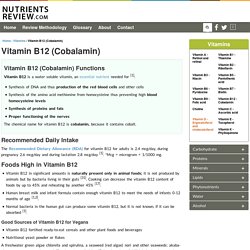
Recommended Daily Intake The Recommended Dietary Allowance (RDA) for vitamin B12 for adults is 2.4 mcg/day, during pregnancy 2.6 mcg/day and during lactation 2.8 mcg/day [1]. Foods High in Vitamin B12 Vitamin B12 in significant amounts is naturally present only in animal foods; it is not produced by animals but by bacteria living in their guts [31].
Good Sources of Vitamin B12 for Vegans Vitamin B12 fortified ready-to-eat cereals and other plant foods and beveragesNutritional yeast powder or flakes References: [1,2,3] Vitamin B12 Absorption, Bioavailability and Stores Causes. Review of Vitamins and Other Nutrient Supplements. Search Methods To find information about nutrients effects, we search online for systematic reviews and meta analyses of randomized controlled trials and large observational studies published in: Grading System and Criteria We use the following grade system to describe the effectiveness of nutrients: EFFECTIVE (high evidence).
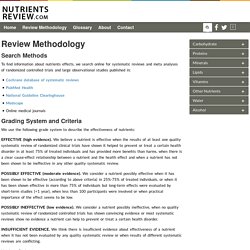
We believe a nutrient is effective when the results of at least one quality systematic review of randomized clinical trials have shown it helped to prevent or treat a certain health disorder in at least 75% of treated individuals and has provided more benefits than harms, when there is a clear cause-effect relationship between a nutrient and the health effect and when a nutrient has not been shown to be ineffective in any other quality systematic review. POSSIBLY EFFECTIVE (moderate evidence). POSSIBLY INEFFECTIVE (low evidence).
INSUFFICIENT EVIDENCE. Healthy eating made easy. As a busy undergraduate at MIT, Christina Bognet decided she wanted to start eating a healthier diet.
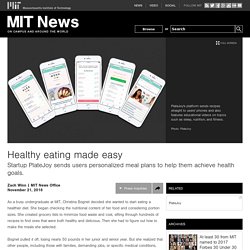
She began checking the nutritional content of her food and considering portion sizes. She created grocery lists to minimize food waste and cost, sifting through hundreds of recipes to find ones that were both healthy and delicious. Then she had to figure out how to make the meals she selected. Bognet pulled it off, losing nearly 50 pounds in her junior and senior year. But she realized that other people, including those with families, demanding jobs, or specific medical conditions, wouldn’t have time to research healthier eating choices and spend hours each week shopping and cooking. That insight led Bognet to found PlateJoy, a meal-planning platform that tailors food recommendations to each user to help them adopt a healthy diet based on their unique lifestyle and health goals.
“We’re building a new category to bridge the gap between medicine and the modern consumer,” Bognet says. Nutrigenomics: Does Food Influence How Our Genes Behave? “It’s in my genes” is a phrase most of us have uttered at one time or another.
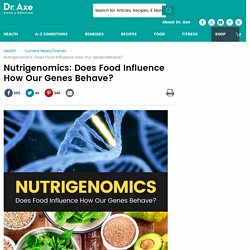
For some it might equate to eating a lot of fatty foods without ever gaining an ounce, while for others it might mean an increased risk to a certain disease because it “runs in the family.” But what if your genes aren’t relegated to how you’re born, but can be changed by your own actions — namely, the foods you eat? That could have long-lasting impact into how we prevent or treat a variety of diseases. What Are Nutrigenomics? Although I’ve always advocated that food is medicine, this next level might sound like sci-fi or a field far in the future. According to the UC Davis NCHMD Center of Excellence for Nutritional Genomics, there are five tenets of nutrigenomics, which can be summarized as: Essentially, nutrigenomics examines how what we eat affects our genes’ activity, like what proteins they produce according to our DNA.
Some of this isn’t entirely new. Another example is how people react to caffeine. 1. Nutrigenomics Archives — BioFoundations. According to Greek mythology, Clotho (Greek: Κλωθώ) is part of the Three Fates or Moirai who spin (Clotho), draw out (Lachesis) and cut (Atropos) the thread of Life.
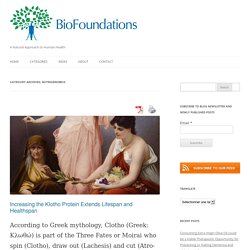
Clotho was responsible for spinning the thread of human life. She also determined when a person was born and when they died. Clotho represented the thread of human life and her decisions represented the fate of all people in society. Similar to Clotho from Greek mythology, Klotho is an enzyme that in humans is encoded by the KL gene. It was discovered in 1997 by scientists and involves the suppression of several ageing phenotypes. Discovered in 1997, Klotho is considered a longevity gene which is expressed in various organs and cells, such as renal tubular cells and the brain choroid.
Klotho fluctuates with age, where in a persons first decade (0 to 10), serum levels are low, then from ages 20 to 40 years, it increases and reaches its peak, and finally after 40 years old it gradually decreases. 1 Figure 1. Figure 2. Food Timeline: food history research service. ViewPort. Dr. Sara Gottfried. Edibility. Supplemental.
MEDICA. Botanica. Pathways. Nutrigenomics. Nutrition. Nutrition Sites & Tools.